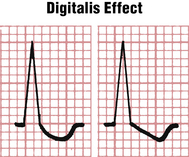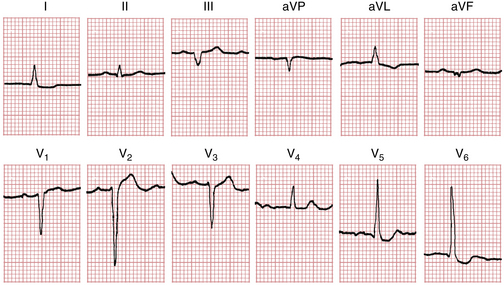Chapter 18 Digitalis Toxicity
Digitalis Toxicity Vs. Digitalis Effect
Digitalis toxicity refers to the arrhythmias and conduction disturbances (as well as the toxic systemic effects described later) produced by this class of drug. Digitalis toxicity should not be confused with digitalis effect. Digitalis effect (Figs. 18-1 and 18-2) refers to the distinct scooping (“thumbprinting” sign) of the ST-T complex (associated with shortening of the QT interval) typically seen in patients taking digitalis glycosides.
Note: The presence of digitalis effect, by itself, does not imply digitalis toxicity and may be seen with therapeutic drug concentrations. However, most patients with digitalis toxicity manifest ST-T changes of digitalis effect on their ECG.
Symptoms and Signs of Digitalis Toxicity
As a general clinical rule virtually any arrhythmia and all degrees of AV heart block can be produced by digitalis. However, a number of arrhythmias and conduction disturbances are commonly seen with digitalis toxicity (Box 18-1). In some cases, combinations of arrhythmias will occur, such as AF with a relatively slow ventricular response and frequent ventricular ectopy (Fig. 18-3).
BOX 18-1 Arrhythmias and Conduction Disturbances Caused by Digitalis Toxicity
∗ Two classes of junctional (nodal) rhythms may occur: (1) a typical junctional escape rhythm with a rate of 60 beats/min or less, and (2) an accelerated junctional rhythm (also called nonparoxysmal junctional tachycardia
Stay updated, free articles. Join our Telegram channel

Full access? Get Clinical Tree




